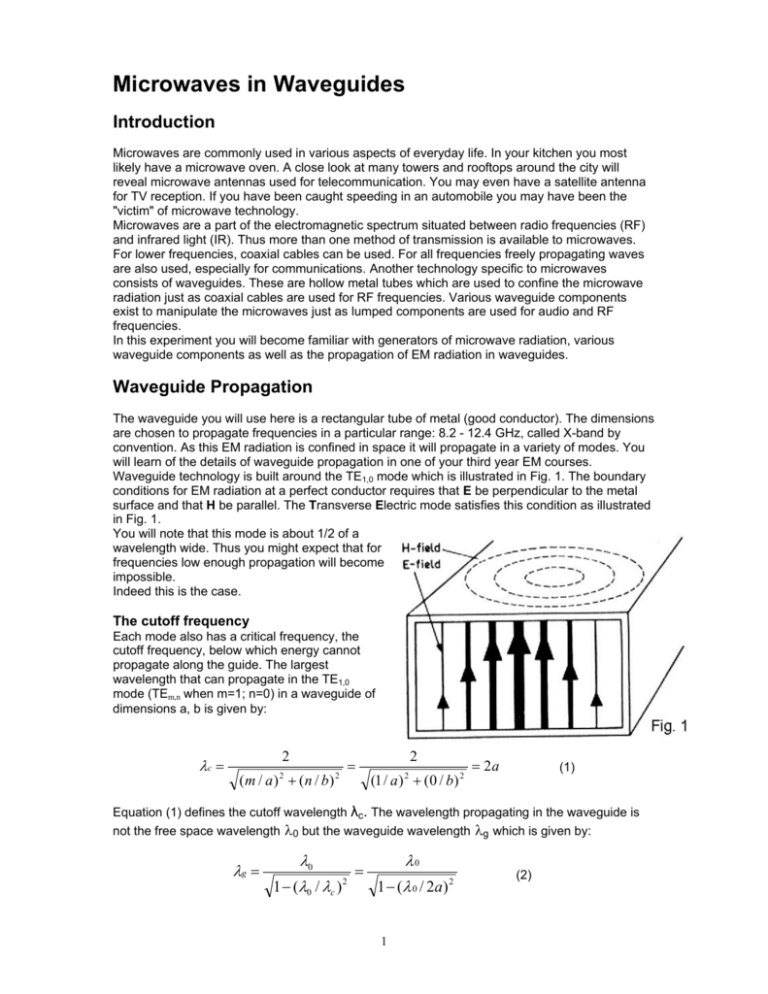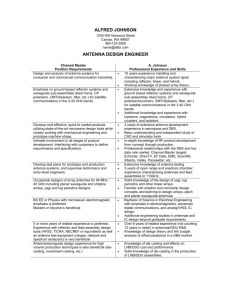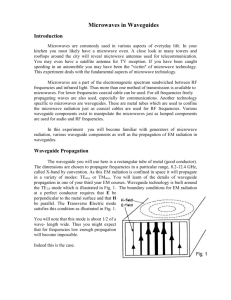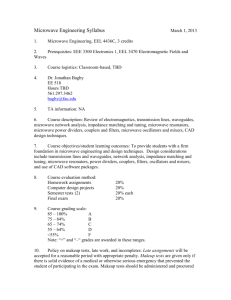Microwaves in Waveguides - University of Manchester
advertisement

Microwaves in Waveguides Introduction Microwaves are commonly used in various aspects of everyday life. In your kitchen you most likely have a microwave oven. A close look at many towers and rooftops around the city will reveal microwave antennas used for telecommunication. You may even have a satellite antenna for TV reception. If you have been caught speeding in an automobile you may have been the "victim" of microwave technology. Microwaves are a part of the electromagnetic spectrum situated between radio frequencies (RF) and infrared light (IR). Thus more than one method of transmission is available to microwaves. For lower frequencies, coaxial cables can be used. For all frequencies freely propagating waves are also used, especially for communications. Another technology specific to microwaves consists of waveguides. These are hollow metal tubes which are used to confine the microwave radiation just as coaxial cables are used for RF frequencies. Various waveguide components exist to manipulate the microwaves just as lumped components are used for audio and RF frequencies. In this experiment you will become familiar with generators of microwave radiation, various waveguide components as well as the propagation of EM radiation in waveguides. Waveguide Propagation The waveguide you will use here is a rectangular tube of metal (good conductor). The dimensions are chosen to propagate frequencies in a particular range: 8.2 - 12.4 GHz, called X-band by convention. As this EM radiation is confined in space it will propagate in a variety of modes. You will learn of the details of waveguide propagation in one of your third year EM courses. Waveguide technology is built around the TE1,0 mode which is illustrated in Fig. 1. The boundary conditions for EM radiation at a perfect conductor requires that E be perpendicular to the metal surface and that H be parallel. The Transverse Electric mode satisfies this condition as illustrated in Fig. 1. You will note that this mode is about 1/2 of a wavelength wide. Thus you might expect that for frequencies low enough propagation will become impossible. Indeed this is the case. The cutoff frequency Each mode also has a critical frequency, the cutoff frequency, below which energy cannot propagate along the guide. The largest wavelength that can propagate in the TE1,0 mode (TEm,n when m=1; n=0) in a waveguide of dimensions a, b is given by: λc = 2 (m / a) 2 + (n / b) 2 = 2 (1 / a ) 2 + (0 / b) 2 = 2a (1) Equation (1) defines the cutoff wavelength λc. The wavelength propagating in the waveguide is not the free space wavelength λ0 but the waveguide wavelength λg which is given by: λg = λ0 1 − (λ0 / λc ) 2 = λ0 1 − (λ 0 / 2a ) 2 1 (2) λg is longer than the free space wavelength. When the waveguide frequency approaches the cutoff frequency the waveguide wavelength diverges and no energy propagates. The frequency is given by f = c / λ0 which can also be expressed in terms of the waveguide wavelength: f = c (1 / λ g ) + (1 / 2a ) 2 2 (3) Both the frequency and wavelength can be measured in this experiment whereby you can verify the above expressions. Attenuation Another concept you should become familiar with, if you are not already, is that of expressing attenuation in terms of decibels (dB). The attenuation of a signal from one point to another is given by: AdB = 10 log 10 P1 P2 (4) where P1 and P2 are the power levels at points 1 and 2 respectively. You will note that the attenuators in this experiment are calibrated in terms of dB. Power is also expressed in terms of dB relative to a particular power level. The unit most convenient for this experiment is the dBm, the power relative to 1mW. Using equation (4) with P1 = P and P2 = 1 mW we obtain: P = 1( mW ) × 10 AdB 10 (5) For example 2 mW is equal to +3 dBm and 0.25 mW is equal to -6 dBm. Microwave Generators There are many different types of microwave signal generators. Two that you can study in this experiment are the reflex klystron and the Gunn diode oscillator. These devices operate on the principle of positive feedback of EM energy to accelerated electrons thereby causing oscillations to occur. Follow the instructions to set up the oscillator and measure the operating mode for the klystron or voltage-current characteristic of the Gunn oscillator. In the following sections the figures have a klystron for the microwave signal generator. You may use either the scope or the SWR meter to measure microwave signals in these experiments. If you us the SWR meter you must use 1HKz modulation. This is sometimes convenient when using the oscilloscope as well. Exercises and Experiments Exercise 1: Operating the reflex klystron Setup the equipment as in Fig. 2 to measure both the frequency and wavelength of the propagating microwaves. 2 Figure 2: Set up for square wave operation of the klystron Energizing the klystron. Square wave operation 1.1 Set the Waveguide Attenuator at 40 dB. Select 30dB, 100Hz -1kHz bandwidth, gain control in center on the SWR meter. Switch on the instrument. 1.2 On the klystron power supply, the “Res/refl.on” button has to be out. Switch on the power supply. Only 6.3 V heater voltage is now supplied to the klystron. 1.3 Select the 1KHz square wave and set the reflector voltage knob in center position (~ 100V). Wait at least 1 min and then press the “Res/refl.on” button. The klystron is supplied now with 300V on the resonator and ~ 100V modulated with 40V square wave on the reflector. 1.4 Set the reflector voltage to a value that gives a maximum SWR – meter deflection (~200V). Resonator current meter should read 10-30 mA. (If no deflection is obtained, select 40dB on the SWR meter and repeat step 4). 1.5 Disconnect the BNC cable from the detector and connect it to the frequency meter. Select 50dB on the SWR meter and tune the frequency meter until the maximum deflection on the SWR meter is achieved. The frequency meter setting at maximal deflection is the klystron output frequency. The klystron frequency increases when the tuning know is tuned counter clockwise. Given this method of operation explain the physical principle behind the operation of the wave meter. The cavity and detector can be setup in two possible configurations leading to either a maximum or minimum of power on resonance. Take this into account in your explanation. Note: when you have finished with the wave meter you should move it well off resonance so that it will not affect your other measurements! Note: To get stable operation it is advisable to let the klystron warm up 10 minutes before performing the steps 1.4, 1.5. 3 Exercise 2: Mode studies on oscilloscope Set up the equipment as in Fig. 3 Figure 3: Set up for oscilloscope studies of the klystron 2.1 Set the variable attenuator at 20 dB. 2.2 The oscilloscope should be used in the X-Y mode. The X EXT input should be connected to the “0-30V, 50Hz” output of the klystron power supply. The detector is connected to the oscilloscope input A on 1V/div DC. 2.3 The klystron has to be set up as follows: power supply on 50Hz~; the “Res./refl on” button is out and the reflector voltage control is in center position. Switch on the power supply. 2.4 The horizontal line now visible on the oscilloscope can be adjusted to be symmetrical around the vertical centerline by using the potentiometer knob at the rear of the klystron power supply and also with the X POSITION knob on the oscilloscope. 2.5 Press the “Res./refl on” button and adjust the reflector voltage to approx. 200V. You should see a pattern similar to Fig. 4. If the pattern is double, adjust the phase of the horizontal input voltage with the potentiometer knob on the back of the power supply. Adjust the vertical sensitivity or the wave guide attenuation to get full vertical deflection. The pattern on the oscilloscope shows one of the klystron modes. The horizontal axis is the reflector voltage axis and the vertical is the power axis. Figure 4: A mode pattern 2.6 Tune the frequency meter until a dip appears on the top of the mode pattern (Fig.5a). The meter setting is the mode-top frequency. Note and record the reflector voltage Vo, the modeamplitude Ao and the frequency of the mode-top fo. 2.7 Change the reflector voltage to get the mode positioned as in Fig.5b. Note and record the reflector voltage V1 (the upper oscillation start voltage). Repeat this step to get the lower oscillation start voltage. 4 a) b) c) d) e) Figure 5: Mode patterns 2.8 Repeat step 2.7 for two more modes. Use the results to draw a mode diagram similar to that in Fig. 6, upper part. Figure 6: Relationship between output power, oscillation frequency and reflector voltage for a klystron 2K25 Exercise 3: Electronic tuning 3.1 Adjust the reflector voltage to get the highest mode on the oscilloscope. Select a frequency of ~9000 MHz. 3.2 Determine the half-power points as follows: adjust the reflector voltage and the frequency meter to get the patterns from Fig. 5c,d,e. Note and record the reflector voltages and the frequencies. Calculate the electronic bandwidth f’-f” and the tuning sensitivity: f '− f " of the V '−V " klystron used in this experiment. Questions: a) When maximizing the SWR meter deflection with the 1 kHz knob, what are you actually doing? b) Why is it recommended to have large bandwidth (100Hz) on the SWR meter when looking for the signal? c) Why does the klystron oscillate only within certain intervals of the reflector voltage? d) Which one of the modes observed by you corresponds to the longest electron transit time? 5 Experiment 1: Frequency, wavelength and attenuation measurements In Exercise 1 we have used the frequency meter to determine the oscillation frequency of the klystron. In this experiment we will calculate the frequency from the wavelength. - Set up the equipment as shown in Fig. 7. - Set the variable attenuator at 20 db and adjust the probe depth of the standing wave detector to the red mark on the scale. - Select 40dB; 100Hz -1KHz bandwidth and gain control in center position on the SWRmeter. - Energize the klystron (use the mode at ~200V reflector voltage, modulate with 1 kHz square wave). Adjust to maximum deflection on the SWR meter Figure 7: Setup for Experiment 1 Frequency measurement: tune the frequency meter until a “dip” is observed in the SWR-meter deflection. Tune the frequency meter to obtain minimum deflection. Note the frequency meter setting Wavelength measurement: replace the termination with the variable short. Detune the frequency meter! - Move the probe along the line, observe the SWR-meter (the deflection will vary strongly). Move the probe to a minimum deflection point. To get an accurate reading it is necessary to increase the SWR-meter gain when close to a minimum. Record the probe position. - Move the probe to the next minimum and record the probe position. Calculate the waveguide wavelength λg as twice the distance between the minima. - Measure the waveguide inner dimension a (the broad dimension). We defined before (Equations 1-5) the waveguide wavelength λg and the cutoff wavelength λc Verify the relation between frequency f and λ g . The knob on the frequency meter adjusts a cavity that is weakly coupled to the waveguide. Attenuation measurement: replace the variable short with the termination. Tune the klystron to 9000MHz. - Adjust the SWR-meter gain to obtain full-scale deflection on the 30dB scale. If necessary change the variable waveguide attenuator setting. Note the micrometer reading on the attenuator. Do not touch the knobs of the SWR-meter anymore! - Increase the waveguide attenuation in 2 dB-steps up to 10dB by turning the micrometer clockwise. Record the corresponding micrometer settings. - Draw a curve over the change in attenuation as a function of the micrometer reading. Compare with the curve attached to the attenuator. 6 Experiment 2: SWR measurements The SWR, standing wave ratio, is the conventional way of measuring the relative amount of traveling waves vs. standing waves. As you may recall properly matched transmission lines propagate EM radiation without reflection whereby all the radiation would be in the form of a traveling wave. If impedance mismatches are introduced, reflections will occur, leading to some standing (stationary) waves. As standing waves are not very useful for the transmission of radiation, the SWR of a waveguide component can be considered a figure of merit. The SWR is defined as the ratio of the maximum electric field amplitude to the minimum electric field amplitude in the waveguide. Thus if all the radiation was propagating there would be a sinusoidal oscillating signal, i.e. E (r , t ) = E 0 sin(ωt − kr ) and the SWR would equal one. Fig. 8 illustrates some examples of standing wave patterns. Figure 8: Standing wave patterns Waveguide technology provides a simple way to directly measure the SWR. A sliding crystal detector can measure the microwave power as a function of position along the waveguide. A sliding screw-tuner can be used to insert a metal stub into the waveguide in a controlled fashion. This allows one to adjust the amount and position of impedance mismatch in the waveguide and thus vary the SWR due to the stub. Imagine trying to design a sliding detector into a coaxial cable! - Setup the apparatus as in Fig. 9. Set the variable attenuator to 20dB. Completely unscrew the probe on the slide screw-tuner (0 on the scale). Adjust the probe depth on the standing wave detector to the red mark on the scale. - Energize the klystron for maximum output at 9.0 GHz. Modulate the reflector with 1000Hz square wave. With the SWR-meter on 40dB and 20Hz, obtain a medium deflection. - Move the probe along the standing wave detector. You’ll observe that deflection changes very little, i.e. transmission line is well matched 7 Figure 9: Set up for Experiment 2 Measurement of low and medium SWR: - Increase the probe depth of the slide screw tuner to 5 mm and move the probe along the standard wave detector to a maximum. - Adjust the SWR-meter gain until the meter indicates 1.0 on the upper scale, move the probe to a minimum and do not change anything else - Measure the SWR of the stub in the sliding screw tuner. Measure the SWR for stub depths of 0, 3.7 and 9 mm. What is the SWR in the limit of ever increasing impedance mismatch? Measurement of high SWR. The double minimum method: - Set the probe depth on the slide screw tuner to 9 mm. Move the probe along the standing wave detector until a minimum is indicated. Adjust the SWR-meter gain to obtain a reading of ~3 dB on the lower scale. - Move the probe on the standing wave detector to the left until full scale deflection is obtained (0 dB on lower scale) Note the probe position (d1). - Repeat the step above but this time move the probe to the right. Note the probe position (d2). - Replace the sliding screw-tuner and matched load with the movable short. Move the short and determine the distance between successive maxima. How is this distance related to λ g ? - Calculate the SWR as: S = 1 + sin λg 1 ≈ π (d1 − d 2 ) 2 π (d1 − d 2 ) (6) λg The Isolator Now that you have been introduced to the concept of SWR you should realize that for many microwave components the manufacturer attempts to minimize the SWR at each waveguide port. Take a look into the isolator ports. What do you see that looks, perhaps, out of place? Why did the manufacturer put these things into the waveguide? With the arrow pointing towards the microwave generator and the variable attenuator at zero measure the microwave power level. Rotate the isolator so that now its arrow points away from the generator. Adjust the attenuator to bring the power level down to the previous setting. Now you can calculate the "insertion loss" of the isolator in the backward direction assuming 0 dB insertion loss in the forward direction. 8 The isolator is a fascinating device which relies on the non-time reversal symmetry of Maxwell's equations to allow transmission in one direction but not the reverse. See appendix B for a brief description of a Faraday-rotation isolator. Isolators are commonly used to protect devices from strong reflections, as we do in this experiment. Microwave oscillators often will not function properly if a large amplitude wave is incident upon them. Experiment 3: Antenna Measurements The open waveguide acts as an antenna. In the case of a rectangular waveguide this antenna presents a mismatch of about 2:1 (SWR = 2) and radiates in many directions. The match will be improved if the open waveguide has a “horn” shape. The radiation pattern of an antenna is a diagram of the field strength or power intensity as a function of the aspect angle at a constant distance from the radiating antenna. It consists of several lobes (see Fig. 10). The major power is concentrated in the main lobe and it is normally desirable to keep the power in the side and back lobes as low as possible. Definitions: - Gain (G): the power intensity at the maximum of the main lobe compared to the power intensity achieved from an imaginary antenna radiating equally in all directions and being fed with the same power. - 3 dB-beamwidth θ: the angle between the two points on a main lobe where the power intensity is half the maximum power intensity When measuring an antenna pattern it is interesting to plot the “far field pattern”, which is achieved at a minimum distance of: Rmin = 2D 2 λo where D is the size of the broad side of the rectangular horn antenna and λ0 is the free space wavelength. It is also important to avoid disturbing reflections. Do not stand too close to the set up; move slowly and keep an eye on the SWR-meter! Figure 10: Antenna pattern Antenna measurements are mostly made with the unknown antenna as receiver. There are several methods to measure the gain of an antenna. One method is to compare the unknown with a “standard gain” antenna. Another method is to use two identical antennas, one as transmitter (power Pt) and the other as receiver (power Pr). The following relation between Pr and Pt can be proved: Pr λ20 2 =G Pt (4πR )2 The gain G is therefore given by: G = 4πR λ0 (7) Pr Pt (8) The two powers (or the ratio only!) and the distance R are measured and G can be calculated. Procedure for antenna diagram plotting: Set up the equipment as in Fig. 11. When horns are in-line, the scale on the rotary joint should indicate 90o. Energize the klystron for maximum output at 9.0 GHz, 1 kHz square wave modulation. Set the variable attenuator at ~ 20 dB. Obtain full scale deflection on the SWR-meter. Take measurements by turning the receiving horn in 10o alternating left-right steps. Repeat at 9.5 GHz. Draw a diagram on polar graph paper. 9 Figure 11: Set up for Experiment 3 Procedure for gain measurement: Set the variable attenuator at ~40 dB. Obtain full scale deflection on the SWR-meter when the horns are in-line. Remove the crystal detector and let it replace the transmitting horn. Readjust the SWR meter to get the deflection on scale (do not touch the gain control knob). Record the gain range and the deflection (incident power). Measure the incident power on the receiving antenna as a function of angle and plot this on polar graph paper. Determine the 3 dB width, in degrees, of the main lobe of the antenna pattern. Why do we elevate the antenna? Appendix A The Gunn Oscillator Figure 12: The Gunn oscillator The Gunn diode oscillator is named after J.B. Gunn who in 1960 was studying high field phenomena in Gallium Arsenide (GaAs). When the applied electrical field was about 2000 V/cm, he discovered oscillations of microwave frequencies. In his own words: ... when I pushed the electric field up to the neighbourhood of 1000 to 2000 V/cm something entirely unexpected happened. Instead of a simple variation of current with voltage, all hell broke loose - the current started to jump up and down in a completely irregular way that very much 10 resembled electrical noise mechanism I knew. The current variations were in the order of amperes rather than the nanoamperes you ordinarily see. Averaging over the microwave oscillations the voltage current behavior was as in Fig. 12. Above the voltage V0 the GaAs diode IV curve develops a negative resistance. Cavity-controlled oscillator In a Gunn oscillator the diode is placed in a resonant cavity. In this case the oscillation frequency is determined by the cavity more than by the diode itself. Biasing in the negative resistance region causes the diode to oscillate at the cavity resonance frequency. Today (1982) the Gunn oscillators dominate the low power local oscillator and the low-power transmitter market above 6 GHz. The oscillation frequency range extends up to 100 GHz. The Gunn oscillators are reliable and low-noise, and produce CW power from a few milliwatts up to a few watts. In this oscillator the cavity consists of a waveguide section with a movable short-circuit section. It can be continuously moved by turning the tuning knob and thus change the oscillation frequency. The Gunn diode is post mounted across the waveguide and the iris serves as an impedance match to the mating waveguide. Appendix B Microwave Isolator Perhaps one of the most important applications of ferrites in microwave circuits is the microwave isolator. A typical microwave isolator is shown in Appendix B - Fig. 1. It consists of a circular waveguide carrying the TE11 mode with transitions for converting the circular mode to rectangular waveguide modes at both ends. In the central region a pencil-shaped ferrite material is introduced. To minimize reflections, the ferrite pencil is tapered gradually at both ends. A permanent magnet is placed outside of the waveguide to provide a longitudinal static magnetic field through the ferrite pencil. The ferrite causes the plane of polarization of the TE11 mode to rotate by an amount determined by the size of the ferrite pencil, its length, and the strength of the magnetic field. The direction of rotation of the plane of polarization is determined by the direction of the static magnetic field. Appendix B Fig. 1 11 The principle of operation of this device can be explained with the help of Appendix B -Fig. 1(b) and (c). The electromagnetic waves at the rectangular TE10 mode enter from the left side and are transformed into the circular TE11 mode by a gradual transition. The plane of polarization of this circular mode is the same as that of the rectangular TE10 mode. In passing through the ferrite, the plane of polarization is rotated clockwise by 45°. The circular mode with the rotated plane of polarization is then converted back into the rectangular mode. The rectangular waveguide at the right is physically oriented in such a way that the plane of polarization of the incoming waves from the left coincides with that of the usual TE10 mode in this guide. Thus the electromagnetic waves propagate through this device from left to right and suffer only a small attenuation in the ferrite material. The propagation of waves in the reverse direction, however, is prevented by the device. Consider, for instance, electromagnetic waves at the rectangular TE10 mode entering the system from the right. After coming through the transition, the mode is converted to the circular TE11 mode when the plane of polarization remains the same as that of the incoming TE10 mode. The ferrite rotates the plane of polarization by 45°, as before, in the clockwise direction. After rotation, the plane of polarization becomes such that the wave can no longer propagate into the rectangular waveguide at the left. A resistive attenuation card can now be placed parallel to the wide dimension of the waveguide at the left to absorb the energy of the waves coming from the right to the left. Thus, under ideal conditions, no propagation from the right to left is possible. Isolators can be used to improve the frequency stability of microwave generators, such as klystrons and magnetrons, where the reflection from the load affects the generating frequency. In such cases the isolator is placed between the microwave generator and the load so that the energy is transmitted from the generator to the load with a very small attenuation. On the other hand, the energy of the reflected waves resulting from the load mismatch is highly absorbed by the isolator. This prevents the frequency instability of the generator. References Sivers-Lab-Philips: Microwaves: basic experiments (reprint available from the Resource Centre) D. M. Pozar: Microwave engineering, J. Wiley 2005 This guide sheet has been re-written in 2006 by R.M. Serbanescu. Previous versions: B.W.Statt 2001 12









